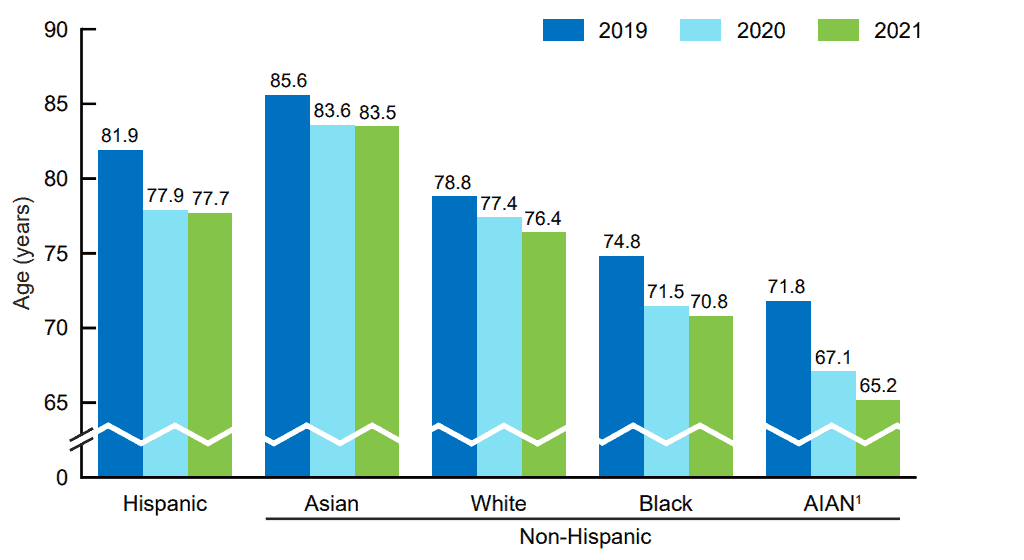Americans born in the year 2021 can expect to live only 76.1 years on average, according to the latest figures from the National Center for Health Statistics (NCHS). In contrast, in 2019, the life expectancy was 78.8 years.
The 2.7 years of decline between 2019 and 2021 marks the sharpest drop in life expectancy since the 1920s. The primary cause for this worrisome statistic is the COVID-19 pandemic, which has claimed more than one million American lives thus far, but 2021 has also seen an increase in the number of people killed by overdoses and motor vehicle-related accidents.

Not all groups have been affected equally by this decline. Native Americans and Alaska Natives (AIAN) have faired the worst, with their life expectancy dropping by a staggering 6.5 years since the pandemic first began in early 2020 to only 65 years, the average life expectancy for all Americans in 1944 at the height of WWII. One in seven Native Americans and Alaska Natives has diabetes and many more struggle with obesity. Both are recognized as major risk factors for dying from COVID.

Health experts have characterized these steep declines as nothing short of “historic,” especially since the U.S. is the only developed country that saw a consecutive drop in life expectancy in 2021, the second year of the pandemic. While most countries have improved their life expectancy after an expected drop in 2020 because of a new and lethal virus, the U.S. continued to experience unnatural levels of attrition among its population in 2021 due to its relatively poor vaccination campaign and the population’s low compliance rate with COVID rules, such as masking and avoiding people in high-risk situations.
White Americans’ life expectancy dropped by a year to 76.4 years in 2021 from 77.4 years in 2020, marking the second-largest decline out of all groups, followed by Black Americans (0.7 years drop), and Hispanic Americans (0.2 years drop). However, Black and Hispanic populations were hit harder than White Americans in the first year of the pandemic, so their overall life expectancy is still lower than White Americans. Asian Americans were the least affected racial and ethnic group in the country with a 2021 life expectancy of 83.5 years, experiencing just a slight drop from 83.6 years in 2020.
“The non-Hispanic AIAN population lost 6.6 years, followed by the Hispanic population with a loss of 4.2 years, the non-Hispanic Black population with a loss of 4.0 years, the non-Hispanic White population with a loss of 2.4 years, and the non-Hispanic Asian population with a loss of 2.1 years. The Hispanic and non-Hispanic Asian populations experienced over 95% of their respective declines during the first year of the pandemic,” the researchers wrote in their study.
Despite vaccination campaigns, more Americans died of COVID-19 in 2021 than in 2020, when vaccines were barely available in the later part of the year, possibly due to more overall infections and more dangerous strains. In fact, lower vaccination correlated with a bigger drop in life expectancy.
To date, just two-thirds of Americans are fully vaccinated, and just one-third are boosted. The large decline in life expectancy among White Americans in 2021 may reflect this group’s greater tendency to resist vaccination and protection rules compared to Black and Hispanics.
The longevity gap between the sexes is also at its widest in years. American women can now expect to live 79.1 years, which is almost 6 more years than men, who have an average life expectancy of only 73.2 years.
These are rather damning statistics, especially since authorities can’t point the finger at COVID-19 forever. Researchers at the NCHS found that the pandemic accounted for about half of the 0.9 years of decline experienced in 2021. An increase in the number of accidents and unintended injuries, which also includes drug overdoses, was responsible for another 16% of the decline.
NCHS researchers mention that their analysis is not final, as they have had to rely on preliminary mortality figures for 2021. However, the data virtually includes 99% of the deaths the researchers expect to have, so the final figures aren’t expected to change much if at all.






